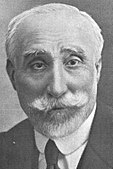| |||||||||||||||||||||||||||||||||||||||||||||||||||||||||||||||||||||||||||||
All 409 seats in the Congress of Deputies and 180 (of 360) seats in the Senate 205 seats needed for a majority in the Congress of Deputies | |||||||||||||||||||||||||||||||||||||||||||||||||||||||||||||||||||||||||||||
|---|---|---|---|---|---|---|---|---|---|---|---|---|---|---|---|---|---|---|---|---|---|---|---|---|---|---|---|---|---|---|---|---|---|---|---|---|---|---|---|---|---|---|---|---|---|---|---|---|---|---|---|---|---|---|---|---|---|---|---|---|---|---|---|---|---|---|---|---|---|---|---|---|---|---|---|---|---|
| |||||||||||||||||||||||||||||||||||||||||||||||||||||||||||||||||||||||||||||
| |||||||||||||||||||||||||||||||||||||||||||||||||||||||||||||||||||||||||||||
The 1918 Spanish general election was held on Sunday, 24 February (for the Congress of Deputies)[a] and on Sunday, 10 March 1918 (for the Senate), to elect the 17th Cortes of the Kingdom of Spain in the Restoration period. All 409 seats in the Congress of Deputies were up for election, as well as 180 of 360 seats in the Senate.
The election was held in the wake of the Spanish crisis of 1917, a series of events that threatened the government and the Restoration system by posing a three-way challenge: military (the Defence Juntas, a military union movement created without the approval of the Spanish legislature), political (the Assembly of Parliamentarians in Barcelona demanding a recognition of regional autonomy) and social (the 1917 general strike in response to the worsening living conditions of the working classes). These three challenges were aggravated by the rising cost of living and high inflation rates resulting from the economic boom sparked by Spain's neutrality in World War I and an uneven redistribution of national income.
The resulting parliament was the most fragmented since the approval of the 1876 Constitution, with neither the ruling liberal bloc of Prime Minister Manuel García Prieto nor the opposition conservative bloc under Eduardo Dato beinge able to muster a parliamentary majority. Amid growing unstability, the feeling that no one was willing or able to seize power and the threat of a possible abdication of King Alfonso XIII, a national unity government was formed between the Conservative, Liberal Democratic, Liberal, Liberal Left, Maurist and Regionalist League parties with Antonio Maura as new prime minister.
- ^ "Febrero de 1918. Día 17. Elecciones generales. Diputados por el artículo 29". National Library of Spain (in Spanish). El Año Político. 1 January 1919. Retrieved 10 April 2023.
Cite error: There are <ref group=lower-alpha> tags or {{efn}} templates on this page, but the references will not show without a {{reflist|group=lower-alpha}} template or {{notelist}} template (see the help page).





